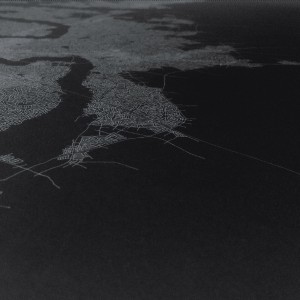 Most of Chartier's recent work and collaborations, both under his own name and his Pinkcourtesyphone alter ego, have focused mostly on presenting tones, both natural and synthetic, in a myriad of understated, minimalist contexts. It is perhaps for this reason that Interior Field has such a different character and mood in comparison, as it of a completely different approach. Made up of field recordings, a technique he has not used since 2010's Fields for Mixing, there is a more hollow, bleaker darkness to be explored here that is quite different for him.
Most of Chartier's recent work and collaborations, both under his own name and his Pinkcourtesyphone alter ego, have focused mostly on presenting tones, both natural and synthetic, in a myriad of understated, minimalist contexts. It is perhaps for this reason that Interior Field has such a different character and mood in comparison, as it of a completely different approach. Made up of field recordings, a technique he has not used since 2010's Fields for Mixing, there is a more hollow, bleaker darkness to be explored here that is quite different for him.
Presented in two long-form pieces, Interior Field continues Chartier's penchant for creating intensely hushed, understated sound art that at times teeters into silence.My first listening to the album was via headphones in a moderately busy café, and I could tell I was missing something.Listening again at home in almost pure silence, a multitude of sound was lurking beneath the surface.Unlike the work of Bernhard Günter, Chartier's work can be appreciated without the requirement of full silence and concentration, it is just not completely realized unless it stands on its own.
The first piece opens with a desolation that feels far more empty and isolated than any of his other works, almost as if there is not the slightest bit of humanity around.Because of this, the recordings take on a disconnected, other worldly quality that makes them much harder to visualize as being anything either in nature or caused by humankind.In other places, there is sound like distant, reverberated fireworks or popping bubble wrap that, with the environmental characteristics they take on a far more sinister character than they should.
At times throughout the lengthy composition, processed recordings of various tones sneak through, a consistency with his work on other recent albums, but the bleak mood never goes away.Shrill, high frequency segments arrive and, even with their low volume levels are undeniable and commanding, as is the occasionally dissonant glitch swipe here or there. Some other moments are mundane (one portion instantly sounded like an amplified recording of a hard drive spinning), and others exotic:the ambience later on has a mechanical, factory type feel to it to truly be describable as "industrial".
Speaking of industry, most of the second piece is based upon binaural recordings at the McMillan Sand Filtration Site in Washington DC, which is marked for demolition some 100-plus years since its construction.Perhaps it is because of this specific location’s limitations, but the second piece is more constant, and does not go through as many changes and evolutions as the first did.Recorded during a significant rainstorm, the constant sound of water becomes a textural element that, even when tones and other noises appear, makes for the more significant facet of this composition.
It is that differing approach to these two pieces that makes the album as a whole so engaging.With the first portion sounding constantly in motion, shifting from place to place and time to time, it allows for a lot of experimentation and evolution to appear.The second, however, is strengthened by its static nature, allowing each part to build and expand and truly setting a mood to be absorbed, albeit a cold and isolated one.Chartier is a rather prolific artist, and he should be commended for his inability to stick to one single approach to sound art.The material that bears his name certainly has commonalities and a consistently high level of quality, but each stands on their own, and this dark, haunting disc is no different.
samples:
 
Read More

